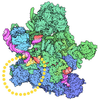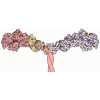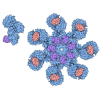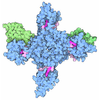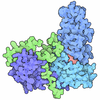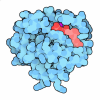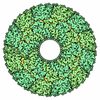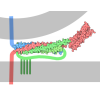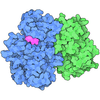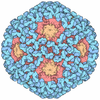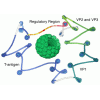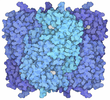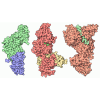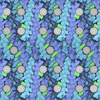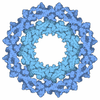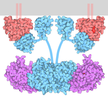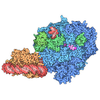+ Open data
Open data
- Basic information
Basic information
| Entry | Database: PDB / ID: 8qr1 | ||||||
|---|---|---|---|---|---|---|---|
| Title | Cryo-EM structure of the human Tip60 complex | ||||||
 Components Components |
| ||||||
 Keywords Keywords | TRANSCRIPTION / Eukaryotic transcription / Histone acetyltransferase / chromatin remodeling / Complex | ||||||
| Function / homology |  Function and homology information Function and homology informationpiccolo histone acetyltransferase complex / promoter-enhancer loop anchoring activity / telomerase RNA localization to Cajal body / regulation of DNA strand elongation / positive regulation of telomere maintenance in response to DNA damage / sperm DNA condensation / positive regulation of norepinephrine uptake / histone chaperone activity / establishment of protein localization to chromatin / R2TP complex ...piccolo histone acetyltransferase complex / promoter-enhancer loop anchoring activity / telomerase RNA localization to Cajal body / regulation of DNA strand elongation / positive regulation of telomere maintenance in response to DNA damage / sperm DNA condensation / positive regulation of norepinephrine uptake / histone chaperone activity / establishment of protein localization to chromatin / R2TP complex / dynein axonemal particle / cellular response to cytochalasin B / bBAF complex / neural retina development / npBAF complex / nBAF complex / brahma complex / regulation of transepithelial transport / Swr1 complex / Formation of annular gap junctions / morphogenesis of a polarized epithelium / Formation of the dystrophin-glycoprotein complex (DGC) / structural constituent of postsynaptic actin cytoskeleton / RPAP3/R2TP/prefoldin-like complex / Gap junction degradation / GBAF complex / Folding of actin by CCT/TriC / regulation of G0 to G1 transition / protein localization to adherens junction / Cell-extracellular matrix interactions / dense body / postsynaptic actin cytoskeleton / protein antigen binding / Tat protein binding / Ino80 complex / chromatin-protein adaptor activity / blastocyst formation / Prefoldin mediated transfer of substrate to CCT/TriC / RSC-type complex / regulation of double-strand break repair / regulation of nucleotide-excision repair / Adherens junctions interactions / RHOF GTPase cycle / adherens junction assembly / apical protein localization / box C/D snoRNP assembly / protein folding chaperone complex / Sensory processing of sound by outer hair cells of the cochlea / Interaction between L1 and Ankyrins / tight junction / SWI/SNF complex / regulation of mitotic metaphase/anaphase transition / Sensory processing of sound by inner hair cells of the cochlea / positive regulation of T cell differentiation / Formation of Senescence-Associated Heterochromatin Foci (SAHF) / apical junction complex / positive regulation of double-strand break repair / regulation of norepinephrine uptake / spinal cord development / negative regulation of gene expression, epigenetic / transporter regulator activity / maintenance of blood-brain barrier / regulation of chromosome organization / nitric-oxide synthase binding / cortical cytoskeleton / Transcriptional Regulation by E2F6 / NuA4 histone acetyltransferase complex / RUNX1 interacts with co-factors whose precise effect on RUNX1 targets is not known / establishment or maintenance of cell polarity / positive regulation of stem cell population maintenance / Regulation of MITF-M-dependent genes involved in pigmentation / Recycling pathway of L1 / TFIID-class transcription factor complex binding / regulation of DNA replication / brush border / regulation of G1/S transition of mitotic cell cycle / MLL1 complex / regulation of embryonic development / Telomere Extension By Telomerase / EPH-ephrin mediated repulsion of cells / somatic stem cell population maintenance / kinesin binding / negative regulation of cell differentiation / spermatid development / RHO GTPases Activate WASPs and WAVEs / regulation of synaptic vesicle endocytosis / enzyme-substrate adaptor activity / positive regulation of myoblast differentiation / RHO GTPases activate IQGAPs / RNA polymerase II core promoter sequence-specific DNA binding / regulation of DNA repair / regulation of protein localization to plasma membrane / positive regulation of double-strand break repair via homologous recombination / EPHB-mediated forward signaling / cytoskeleton organization / Deposition of new CENPA-containing nucleosomes at the centromere / substantia nigra development / telomere maintenance / DNA helicase activity / transcription initiation-coupled chromatin remodeling Similarity search - Function | ||||||
| Biological species |  Homo sapiens (human) Homo sapiens (human) | ||||||
| Method | ELECTRON MICROSCOPY / single particle reconstruction / cryo EM / Resolution: 2.4 Å | ||||||
 Authors Authors | Li, C. / Smirnova, E. / Schnitzler, C. / Crucifix, C. / Concordet, J.P. / Brion, A. / Poterszman, A. / Schultz, P. / Papai, G. / Ben-Shem, A. | ||||||
| Funding support |  France, 1items France, 1items
| ||||||
 Citation Citation |  Journal: Nature / Year: 2024 Journal: Nature / Year: 2024Title: Structure of the human TIP60-C histone exchange and acetyltransferase complex. Authors: Changqing Li / Ekaterina Smirnova / Charlotte Schnitzler / Corinne Crucifix / Jean Paul Concordet / Alice Brion / Arnaud Poterszman / Patrick Schultz / Gabor Papai / Adam Ben-Shem /  Abstract: Chromatin structure is a key regulator of DNA transcription, replication and repair. In humans, the TIP60-EP400 complex (TIP60-C) is a 20-subunit assembly that affects chromatin structure through two ...Chromatin structure is a key regulator of DNA transcription, replication and repair. In humans, the TIP60-EP400 complex (TIP60-C) is a 20-subunit assembly that affects chromatin structure through two enzymatic activities: ATP-dependent exchange of histone H2A-H2B for H2A.Z-H2B, and histone acetylation. In yeast, however, these activities are performed by two independent complexes-SWR1 and NuA4, respectively. How the activities of the two complexes are merged into one supercomplex in humans, and what this association entails for the structure and mechanism of the proteins and their recruitment to chromatin, are unknown. Here we describe the structure of the endogenous human TIP60-C. We find a three-lobed architecture composed of SWR1-like (SWR1L) and NuA4-like (NuA4L) parts, which associate with a TRRAP activator-binding module. The huge EP400 subunit contains the ATPase motor, traverses the junction between SWR1L and NuA4L twice and constitutes the scaffold of the three-lobed architecture. NuA4L is completely rearranged compared with its yeast counterpart. TRRAP is flexibly tethered to NuA4L-in stark contrast to its robust connection to the completely opposite side of NuA4 in yeast. A modelled nucleosome bound to SWR1L, supported by tests of TIP60-C activity, suggests that some aspects of the histone exchange mechanism diverge from what is seen in yeast. Furthermore, a fixed actin module (as opposed to the mobile actin subcomplex in SWR1; ref. ), the flexibility of TRRAP and the weak effect of extranucleosomal DNA on exchange activity lead to a different, activator-based mode of enlisting TIP60-C to chromatin. | ||||||
| History |
|
- Structure visualization
Structure visualization
| Structure viewer | Molecule:  Molmil Molmil Jmol/JSmol Jmol/JSmol |
|---|
- Downloads & links
Downloads & links
- Download
Download
| PDBx/mmCIF format |  8qr1.cif.gz 8qr1.cif.gz | 1 MB | Display |  PDBx/mmCIF format PDBx/mmCIF format |
|---|---|---|---|---|
| PDB format |  pdb8qr1.ent.gz pdb8qr1.ent.gz | Display |  PDB format PDB format | |
| PDBx/mmJSON format |  8qr1.json.gz 8qr1.json.gz | Tree view |  PDBx/mmJSON format PDBx/mmJSON format | |
| Others |  Other downloads Other downloads |
-Validation report
| Summary document |  8qr1_validation.pdf.gz 8qr1_validation.pdf.gz | 974.3 KB | Display |  wwPDB validaton report wwPDB validaton report |
|---|---|---|---|---|
| Full document |  8qr1_full_validation.pdf.gz 8qr1_full_validation.pdf.gz | 986.7 KB | Display | |
| Data in XML |  8qr1_validation.xml.gz 8qr1_validation.xml.gz | 113.9 KB | Display | |
| Data in CIF |  8qr1_validation.cif.gz 8qr1_validation.cif.gz | 184.5 KB | Display | |
| Arichive directory |  https://data.pdbj.org/pub/pdb/validation_reports/qr/8qr1 https://data.pdbj.org/pub/pdb/validation_reports/qr/8qr1 ftp://data.pdbj.org/pub/pdb/validation_reports/qr/8qr1 ftp://data.pdbj.org/pub/pdb/validation_reports/qr/8qr1 | HTTPS FTP |
-Related structure data
| Related structure data |  18611MC 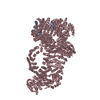 8qriC C: citing same article ( M: map data used to model this data |
|---|---|
| Similar structure data | Similarity search - Function & homology  F&H Search F&H Search |
- Links
Links
- Assembly
Assembly
| Deposited unit | 
|
|---|---|
| 1 |
|
- Components
Components
-Protein , 8 types, 13 molecules ACFSBGKLIEHDJ
| #1: Protein | Mass: 343867.312 Da / Num. of mol.: 1 / Source method: isolated from a natural source / Source: (natural)  Homo sapiens (human) / Cell line: K562 Homo sapiens (human) / Cell line: K562References: UniProt: Q96L91, Hydrolases; Acting on acid anhydrides; Acting on acid anhydrides to facilitate cellular and subcellular movement | ||||||
|---|---|---|---|---|---|---|---|
| #2: Protein | Mass: 93589.172 Da / Num. of mol.: 1 / Source method: isolated from a natural source / Source: (natural)  Homo sapiens (human) / Cell line: K562 / References: UniProt: Q9H2F5 Homo sapiens (human) / Cell line: K562 / References: UniProt: Q9H2F5 | ||||||
| #3: Protein | Mass: 53090.699 Da / Num. of mol.: 1 / Source method: isolated from a natural source / Source: (natural)  Homo sapiens (human) / Cell line: K562 / References: UniProt: Q9NPF5 Homo sapiens (human) / Cell line: K562 / References: UniProt: Q9NPF5 | ||||||
| #4: Protein | Mass: 40658.363 Da / Num. of mol.: 1 / Source method: isolated from a natural source / Source: (natural)  Homo sapiens (human) / Cell line: K562 / References: UniProt: Q15906 Homo sapiens (human) / Cell line: K562 / References: UniProt: Q15906 | ||||||
| #5: Protein | Mass: 41782.660 Da / Num. of mol.: 2 / Source method: isolated from a natural source / Source: (natural)  Homo sapiens (human) / Cell line: K562 / References: UniProt: P60709 Homo sapiens (human) / Cell line: K562 / References: UniProt: P60709#6: Protein | | Mass: 47509.812 Da / Num. of mol.: 1 / Source method: isolated from a natural source / Source: (natural)  Homo sapiens (human) / Cell line: K562 / References: UniProt: O96019 Homo sapiens (human) / Cell line: K562 / References: UniProt: O96019#7: Protein | Mass: 50296.914 Da / Num. of mol.: 3 / Source method: isolated from a natural source / Source: (natural)  Homo sapiens (human) / Cell line: K562 / References: UniProt: Q9Y265, DNA helicase Homo sapiens (human) / Cell line: K562 / References: UniProt: Q9Y265, DNA helicase#8: Protein | Mass: 51222.465 Da / Num. of mol.: 3 / Source method: isolated from a natural source / Source: (natural)  Homo sapiens (human) / Cell line: K562 / References: UniProt: Q9Y230, DNA helicase Homo sapiens (human) / Cell line: K562 / References: UniProt: Q9Y230, DNA helicase |
-Details
| Has protein modification | N |
|---|
-Experimental details
-Experiment
| Experiment | Method: ELECTRON MICROSCOPY |
|---|---|
| EM experiment | Aggregation state: PARTICLE / 3D reconstruction method: single particle reconstruction |
- Sample preparation
Sample preparation
| Component | Name: Tip60 complex / Type: CELL / Entity ID: all / Source: NATURAL | ||||||||||||||||||||||||||||||||
|---|---|---|---|---|---|---|---|---|---|---|---|---|---|---|---|---|---|---|---|---|---|---|---|---|---|---|---|---|---|---|---|---|---|
| Source (natural) | Organism:  Homo sapiens (human) / Strain: K562 / Cellular location: nucleus Homo sapiens (human) / Strain: K562 / Cellular location: nucleus | ||||||||||||||||||||||||||||||||
| Buffer solution | pH: 8 | ||||||||||||||||||||||||||||||||
| Buffer component |
| ||||||||||||||||||||||||||||||||
| Specimen | Conc.: 0.2 mg/ml / Embedding applied: NO / Shadowing applied: NO / Staining applied: NO / Vitrification applied: YES | ||||||||||||||||||||||||||||||||
| Vitrification | Instrument: FEI VITROBOT MARK IV / Cryogen name: ETHANE / Humidity: 95 % / Chamber temperature: 279 K |
- Electron microscopy imaging
Electron microscopy imaging
| Experimental equipment |  Model: Titan Krios / Image courtesy: FEI Company | ||||||||||||
|---|---|---|---|---|---|---|---|---|---|---|---|---|---|
| Microscopy | Model: FEI TITAN KRIOS | ||||||||||||
| Electron gun | Electron source:  FIELD EMISSION GUN / Accelerating voltage: 300 kV / Illumination mode: FLOOD BEAM FIELD EMISSION GUN / Accelerating voltage: 300 kV / Illumination mode: FLOOD BEAM | ||||||||||||
| Electron lens | Mode: BRIGHT FIELD / Nominal defocus max: 2800 nm / Nominal defocus min: 1200 nm / Cs: 2.7 mm / Alignment procedure: COMA FREE | ||||||||||||
| Specimen holder | Cryogen: NITROGEN / Specimen holder model: FEI TITAN KRIOS AUTOGRID HOLDER | ||||||||||||
| Image recording |
|
- Processing
Processing
| EM software |
| ||||||||||||||||||||||||||||||
|---|---|---|---|---|---|---|---|---|---|---|---|---|---|---|---|---|---|---|---|---|---|---|---|---|---|---|---|---|---|---|---|
| CTF correction | Type: PHASE FLIPPING AND AMPLITUDE CORRECTION | ||||||||||||||||||||||||||||||
| Particle selection | Num. of particles selected: 284286 | ||||||||||||||||||||||||||||||
| 3D reconstruction | Resolution: 2.4 Å / Resolution method: FSC 0.143 CUT-OFF / Num. of particles: 180397 / Symmetry type: POINT | ||||||||||||||||||||||||||||||
| Atomic model building | Protocol: RIGID BODY FIT / Space: REAL |
 Movie
Movie Controller
Controller




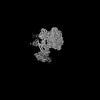







 PDBj
PDBj
